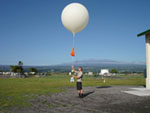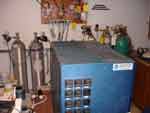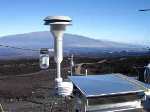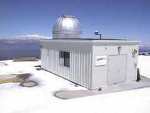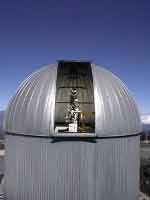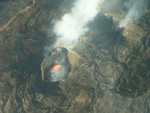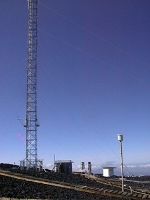More than two years after road access and electrical power to the Mauna Loa Observatory was cut off by lava flows, NOAA staff continue to make critical measurements of the atmosphere and other environmental variables at the remote site.
In 2023, observatory staff installed solar panels at the site and resumed some measurements, including the independent carbon dioxide monitoring programs run by the Global Monitoring Laboratory and Scripps Institution of Oceanography, as well as other atmospheric measurements.
Construction of a temporary road to access the observatory site is anticipated to begin in summer 2025.
Media can contact: Theo Stein (303) 819-7409 (theo.stein@noaa.gov)
Mauna Loa Atmospheric Research Programs
Mauna Loa Observatory has been home to hundreds of atmospheric research programs involving numerous cooperative organizations and related to a diverse spectrum of research categories. Each of our past and present programs has a web page with general project information, photographs, instrument descriptions, web links, trends, important results, and remarks about the program's role in global climate change from its principle investigator.
Research Categories
Greenhouse Gases & Carbon Cycle
- Cooperative Global Air Sampling Network - Greenhouse Gases (NOAA GML)
- In Situ Carbon Monoxide (CO) Measurements (NOAA GML)
- In Situ Carbon Dioxide (CO2) Measurements (NOAA GML)
- In Situ Methane (CH4) Measurements (NOAA GML)
- Atmospheric Research - Greenhouse Gases (CSIRO)
- Measurements of 14CO in the NH Tropics (NSF)
- Carbon Dioxide (CO2) Measurements (Scripps)
- Oxygen (O2) Concentration Measurements (Scripps)
The Greenhouse Gases and Carbon Cycle research program makes flask sample measurements from land sites, sea-surface sites, and aircraft, and makes continuous measurements from baseline observatories and tall towers. These measurements document the spatial and temporal distributions of greenhouse gases and provide essential information to our understanding of the global carbon cycle. GML also uses inverse models to determine global sources and sinks of carbon dioxide.
Ozone & Water Vapor
The Ozone and Water Vapor research program conducts research on the nature and causes of the depletion of the stratospheric ozone layer and the role of stratospheric and tropospheric ozone and water vapor in forcing climate change. This mission is accomplished through long-term observations and intensive field programs that measure total column ozone, ozone vertical profiles (ozonesondes and umkehrs), ground level ozone, and water vapor vertical profiles in the upper troposphere and stratosphere.
Halocarbons and other Atmospheric Trace Species (HATS)
The Halocarbons and other Atmospheric Trace Species research program quantifies the distribution and the magnitudes of the sources and sinks for atmospheric nitrous oxide and halocarbons, that include the chlorofluorocarbons, chlorinated solvents, methly halides, halons and other important ozone-depleting and greenhouse gases. Ground-based stations, towers, ocean vessels, aircraft, and balloons are utilized to accomplish this.
Aerosols and Air Quality
- In Situ Measurements of Aerosol Optical Properties (NOAA ESRL)
- Global Atmosphere Passive Sampling (GAPS) Network (EC)
- AERONET (Aerosol Robotic Network) (NASA)
- Measurements of Free Tropospheric Nitric Acid and Aerosols (UH-Manoa)
- Comparison of Aerosol Organic Carbon Measurements and Models in the Free Troposphere (UH-Manoa)
- WMO Precision Filter Radiometer (PMOD WRC)
- Elemental, Particulate, and Reactive Gaseous Mercury Monitoring (EPA)
- retired Chemical and Isotopic Studies of Atmospheric Aerosol Sources, Transport and Evolution (UC-San Diego)
- retired Dichotomous Partisol Measurements (EPA)
- retired Sequential Fine Particle Sampler (EPA)
- retired Relationships Between Mineral Dust and Radionuclides from Historical Nuclear Weapons Tests (NMSU)
- retired 4 Wavelength Nephelometer (NOAA ESRL)
- retired Aerosol Aethalometer (NOAA ESRL)
- retired Ion Exchange Column (DHS / USDE)
- retired Radio Nuclide Program (DHS / USDE)
- retired Variability in Accretion Rate of Interplanetary Dust Using 3He as Tracer (NASA/ Cal-Tech)
- retired Pollak Condensation Nuclei Counter (CNC) (NOAA ESRL)
- retired Solar Turbidity (NOAA ESRL)
- retired VOGNET (NOAA ESRL / OAR / DOE / HPA)
- retired IMPROVE (Interagency Monitoring of Protected Visual Environments) (UC-Davis)
See also NDACC
The Aerosols and Air Quality research program studies the behaviour of atmospheric aerosols. The goals of this regional-scale monitoring program are to characterize the means, variability, trends, and climate-forcing properties of different types of aerosols, and to understand the factors that control these aerosols.
Lidar
- GMD Lidar Network - General Information (NOAA ESRL)
- Lidar at Mauna Loa, Hawaii (MLO) (NOAA ESRL)
- CLidar at Mauna Loa, Hawaii (CCD Camera Lidar) (NOAA ESRL / CCSU)
- Lidar at Boulder, Colorado(NOAA ESRL)
- Lidar at Pago Pago, American Samoa (SMO) (NOAA ESRL)
- retired Lidar at Trinidad Head, California (THD) (NOAA ESRL / NASA MPLNET)
- Lidar: Stratospheric Ozone, Temperature, and Aerosol Profiles (NDACC / NASA JPL)
- Groundwinds Lidar System (UNH)
The Lidar research program consists of the entire NOAA GML Lidar network. There are Lidar and Camera Lidar programs at MLO as well as Lidar programs at 3 other GML Lidar facilities: American Samoa, South Pole, and Boulder, Colorado. General information about the entire GML Lidar network is provided with the MLO website because MLO station chief John Barnes is a lead investigator for the network, and all GML Lidar data is processed at MLO. The Lidar instruments are capable of obtaining tropospheric and stratospheric Aerosol, Water Vapor, and Temperature profiles.
Meteorology
- Meteorology (NOAA ESRL)
- Precipitation Chemistry (NOAA ESRL)
- U.S. Climate Reference Network (CRN)
- Global Positioning System (GPS) Meteorology (FSL)
- Groundwinds Lidar System (UNH)
- Maximum / Minimum Temperature & Precipitation (NWS)
- ROSA Maximum / Minimum Temperature & Precipitation (NWS)
- upcoming Mercury Precipitation Collection (EPA)
- retired Meteorology Barometer (NOAA ESRL)
Solar Radiation
- Solar and Infrared Radiation (NOAA ESRL GMD)
- CERES (Clouds' and Earth's Radiant Energy System) (NASA)
- GLOBE Sun Photometers (NSF / Drexel University)
- Ultraviolet-B (UV-B) Monitoring & Research Program (USDA / CSU)
- MLSO HAO (Mauna Loa Solar Observatory High Altitude Observatory)
- WMO Precision Filter Radiometer (PMOD WRC)
- Multi-Filter Rotating Shadowband Radiometer (MFRSR) Aerosol Monitoring Network (UH-Manoa / Albireo Endeavors / PNNL)
- Aeolian Dust Experiment on Climate Impact (MRI)
- retired Solar Turbidity (NOAA ESRL GMD)
See also NDACC
The Solar Radiation Group studies the behaviour of atmospheric solar radiation. The goals of this regional-scale monitoring program are to characterize the means, variability, trends, and climate-forcing properties of solar radiation, and to understand the factors that control solar radiation.
NDACC
- Long Term Brewer Calibrations (NDACC / EC)
- FTIR (Fourier Transform Infrared Spectroscopy) Monitoring (NDACC / NCAR)
- Lidar: Stratospheric Ozone, Temperature, and Aerosol Profiles (NDACC / NASA JPL)
- Microwave Measurements of Ozone (NDACC / U-Mass / NIWA)
- Bromine Oxide Monitoring (NDACC / NOAA ESRL / NIWA)
- Nitrogen Dioxide Monitoring (NDACC / NOAA ESRL / NIWA)
- Ultraviolet Spectroradiometer (NDACC / NOAA ESRL / NIWA)
- Water-Vapor Mm-Wave Spectrometer (NDACC / NRL / NASA)
The international Network for the Detection of Atmospheric Composition Change (NDACC) is composed of more than 70 high-quality, remote-sensing research stations for observing and understanding the physical and chemical state of the stratosphere and upper troposphere and for assessing the impact of stratosphere changes on the underlying troposphere and on global climate.
Volcanic Activity
Radioactivity
Other
- Mauna Loa Web Camera System (NOAA ESRL)
- Ambient Ion Monitor (EPA)
- National Satellite Test Bed at Mauna Loa (FAA)
- Pohakuloa Training Area Range Surveillance System (PMRF)
- High-Altitude Environment Corrosion Project (UH-Manoa)
- VYSOS (The Variable Young Star Optical Survey) (UH-Manoa)
- CRONUS - Earth (Cosmic Ray Produced Nuclide Systematics on Earth) (University of Arizona)
- AMIBA (Array For Microwave Background Anisotropy)
- GONG (Global Oscillation Network Group)


